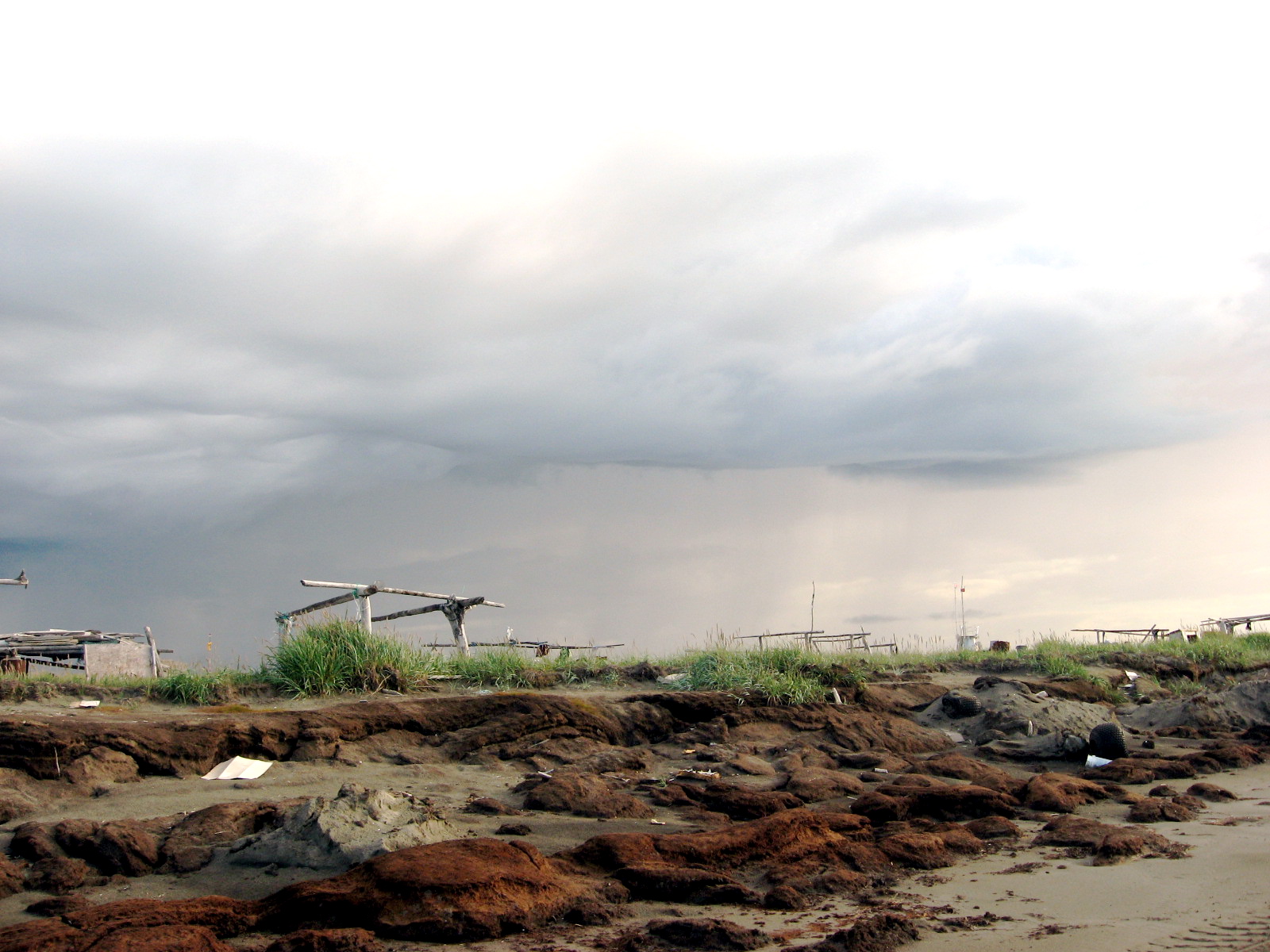It’s a Wednesday morning in late August, the first day of classes at the Shishmaref School. The doors of the pale blue building haven’t opened yet, and the new principal is hurriedly buttering toast in the kitchen for the students’ breakfasts. Teachers are scrambling to make last-minute adjustments to their classrooms, while anxious kids, ranging from pre-K students through high schoolers, wait on the porch, their jackets zipped against the chill of the early-morning air. It’s all so incredibly normal, you might not know that, just a few years ago, no one thought Shishmaref would be here anymore.
The remote village of 563 people is located 30 miles south of the Arctic Circle, flanked by the Chukchi Sea to the north and an inlet to the south, and it sits atop rapidly melting permafrost. In the last decades, the island’s shores have been eroding into the sea, falling off in giant chunks whenever a big storm hits.
The residents of Shishmaref, most of whom are Alaska Native Inupiaq people, have tried to counter these problems, moving houses away from the cliffs and constructing barriers along the northern shore to try to turn back the waves. But in July 2002, looking at the long-term reality facing the island, they voted to pack up and move the town elsewhere.
Relocation has proven much more difficult than that single vote, however. And 12 years later, Shishmaref is still here, ready to begin another school year.
There are obvious signs that something is amiss, however. One of the first things you see as you arrive in Shishmaref is a small wooden building propped precariously on the edge of the beach. A back corner dangles over the edge of an incline, the water lapping just a few feet away.
The town is built on a narrow spit of fine, silt-like sand just three miles long and a quarter-mile wide, surrounded on all sides by water. The only way in or out is by boat or plane, an hour-long flight from Nome that costs around $400 round-trip. A single, short paved road on the island starts just outside of town and leads to the airport; the rest of Shishmaref’s streets are sand. Most people get around on ATVs and dirt bikes, or snowmobiles in the winter.
Most houses don’t have running water or plumbing, so the town captures rain and snow for reuse, and most residents shower and do their laundry at the public washeteria. Full-time jobs are rare, and even part-time employment is hard to come by. Given the shrinking size of the island, there’s not much room for new housing or facilities. In some homes, multiple generations crowd into small, single-story wooden structures. Most families rely on subsistence hunting, fishing and berry-picking to get through the year. The town is known throughout the region for producing seal oil and carvings from bone and ivory, which are sold to visitors and at gift shops in Nome.
Everything else on the island — vehicles, food, construction supplies for houses — must be shipped in. As a result, fresh food, aside from what they can hunt or pick, is rare, and prices at the general store would be outrageous to anyone from the lower 48 states: $14.76 for a can of Lysol, $21.61 for a package of six Huggies diapers, $7.40 for a box of Raisin Bran. Gasoline and heating oil are also shipped in at a premium, with a year’s supply arriving each summer on a barge. A gallon will run you north of $6, and when supplies run out here, there is nothing until the barge returns.
During my August visit, the island had exhausted the year’s gasoline supply, and the next shipment wasn’t expected for another week or two. Residents were forced to ration out what they used for their ATVs and motorboats.
The island’s original name in the native language was “Kigiktaq,” and archaeological evidence of habitation dates back to the 1600s. The island is surrounded by what is now the Bering Land Bridge National Preserve, 2.7 million acres set aside as part of the National Park system to preserve the natural and archeological integrity of the entry point for North America’s first human residents. Russian explorers who arrived here in 1816 named the inlet “Shishmarev,” after the Russian navigator Glieb Semenovich Shishmarev, which would become the town’s name. The island opened a post office in 1901, according to local history, but the town wasn’t officially incorporated until 1969.
Older photos of the island show wide, sandy beaches. Village elders remember playing tag and “Eskimo baseball” on the beach until late into the night, since the sun still shines well past 11 p.m. at the height of summer.
“There was a real big beach down there,” remembers Nora Kuzuguk, 67. “It was our playground.”
Now, those beaches are rapidly disappearing.
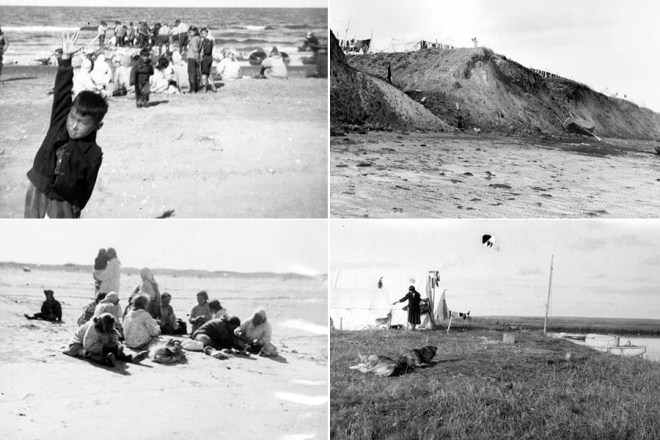
Older photos of the island show wide, sandy beaches. Village elders remember playing tag and “Eskimo baseball” on the beach until late into the night. Alaska State Library Historical Collections
The island has dealt with erosion issues since at least the 1950s. But now climate change is exacerbating the problem considerably. Average temperatures are increasing faster in Alaska than they are in the rest of the United States, warming 3.4 degrees Fahrenheit in the last 50 years. The higher temperatures are causing the subsurface layer of permanently frozen soil typically found in the Arctic to thaw in some areas. This weaker permafrost is more vulnerable to storms and tidal activity, fueling the loss of Shishmaref’s shores.
Warmer temperatures have also shortened the amount of time the Chukchi Sea stays frozen each year, leaving the coastline exposed to fall and early winter storms. Now, during storms, the sand will “just melt with the water,” said Luci Eningowuk, 65. From 2004 to 2008 Eningowuk served as chair of the Shishmaref Erosion and Relocation Coalition, the group charged with developing and executing a plan for moving the town. “The waves would come and take a whole lot of the land.”
Fourteen houses on Shishmaref’s north side had to be put on skids and dragged down to the opposite end of the island after a major storm in October 1997. Another big storm in October 2001 sloughed off huge chunks of the northern shoreline.
Based on a comparison of aerial photos, the Army Corps of Engineers estimates that the island is losing between 2.7 and 8.9 feet a year, on average. But measurements in years with big storms have documented land loss of up to 22.6 feet.
When its residents voted to relocate, Shishmaref became a poster child for the impact of climate change. A webpage for the Environmental Protection Agency describing climate change’s effects in Alaska includes a photo of one of the Shishmaref houses falling off a cliff. “Severe erosion has forced some Alaska Native Villages’ populations to relocate in order to protect lives and property,” the website notes. But while Shishmaref and several other villages have tried to move, they’ve found that the reality of doing so is much more complicated.
There’s a still too-prevalent idea in the United States that climate change is just a concept, an idea removed from us in time, distance, or economic circumstance. It’s something that might affect future generations or other nations. Discussions about the current reality of climate change tend to focus on small island nations like Tuvalu, the Maldives, or Kiribati, which are so threatened by rising seas that they’ve considered acquiring land on other continents so they can move their entire countries.
But you don’t have to look elsewhere. Native communities along Alaska’s coast have been trying to tell us for more than a decade that climate change’s effects are already here.
If you believe the grim predictions of the latest climate science, Shishmaref is just the beginning. Towns in low-lying coastal plains and flood-prone river basins in the lower 48 may be next. A study from the U.S. Geological Survey warns that 50 percent of the U.S. coastline is at high or very high risk of impacts due to sea-level rise; according to the National Oceanic and Atmospheric Administration, 16.4 million Americans live in the coastal flood plain. If we can’t figure out how to save a village with fewer than 600 people from falling into the sea, what hope is there for everyone else?
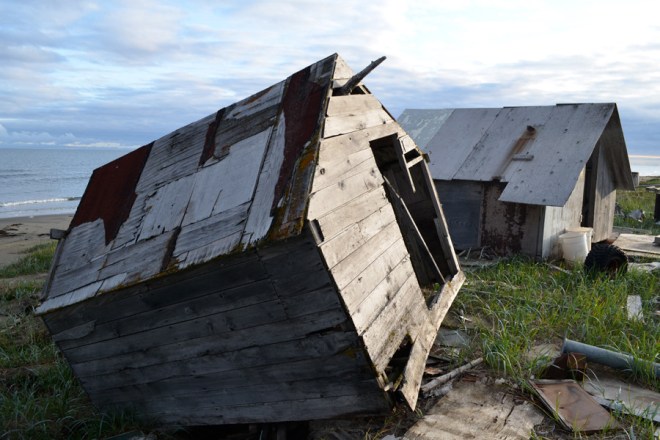
It’s obvious that something is wrong in Shishmaref. One of the first things you see as you arrive is a small wooden building propped precariously on the edge of the beach.Kate Sheppard/The Huffington Post
The cockeyed wooden building visible upon landing in Shishmaref belongs to Tony Weyiouanna Sr., 55, who uses it to preserve fish and render seal oil. Weyiouanna is the president of the board of the Shishmaref Native Corporation, which manages the land and resources allocated to the community under the Alaska Native Claims Settlement Act. When the village first voted to relocate, he was tasked with heading up the effort as the technical staff assistant for the relocation coalition, which included representatives from the city council, the native government and the native corporation. At the time, Weyiouanna was working as the transportation planner for Kawerak, the regional economic and social development association, where he dealt with roads and other public works projects.
Transportation planning is one thing. Planning to move a town is another. “I was like, ‘How the heck am I going to do this?'” remembers Weyiouanna. We’re sitting at his kitchen table drinking coffee as he recalls the relocation effort’s early days. He pauses occasionally to check a reindeer roast in the oven, and the smell, rich and earthy, fills the small house. One of his three children lounges on the couch in the adjoining living room, watching television.
The coalition put together a detailed action plan, laying out for the community and for state and federal agencies what an “orderly relocation” would entail. Step one was to identify high-potential relocation sites, sizeable enough to accommodate the town’s growing population, with access to land and water and the hunting and fishing grounds on which the residents’ ancestors had relied for generations. The geography, hydrology, and environmental suitability of the sites would be studied. The town would determine infrastructure needs for the new community, like an airport, roads, a clinic, and a school. Finally, they would salvage what they could from Shishmaref and clean up the island after they left.
All of this, of course, would require money. An Army Corps of Engineers study in 2004 estimated that relocating Shishmaref to the Alaska mainland would cost $179 million. Weyiouanna and other members of the coalition set about lobbying state and federal agencies for financial support. The town also created a website under the banner “We Are Worth Saving!” that pleaded for donations, technical assistance and grant-writing help from anyone willing to volunteer their time.
Their efforts were aided by a flood of press attention following the town’s decision to relocate. Weyiouanna estimates that around 65 different news crews visited the island in 2003 and 2004 alone, from all over the lower 48 and the world. “To me they were a major player,” he said. “It was a tool for me to convince somebody from D.C., Juneau, Anchorage, that we needed assistance.”
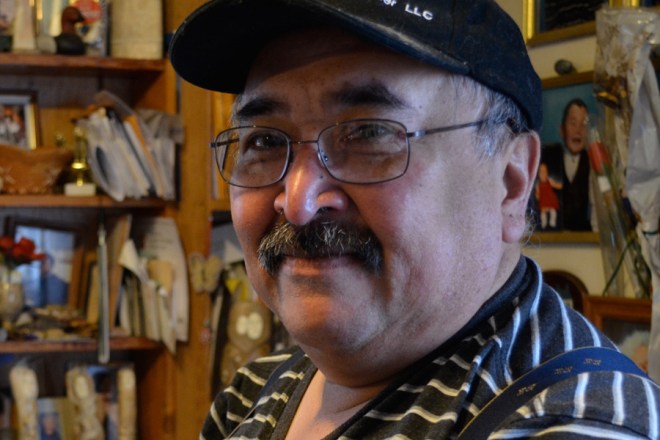
Tony Weyiouanna Sr. helped put the town’s relocation plan together. “I was like, ‘How the heck am I going to do this?'” he remembers.Kate Sheppard/The Huffington Post
The town identified 11 possible relocation sites on the mainland, and preliminary assessments conducted by the U.S. Department of Agriculture’s Natural Resources Conservation Service helped the town narrow the list down to two sites.
At a public meeting in December 2006, the village selected a site called Tin Creek, across the inlet from Shishmaref and less than 12 miles away, as their new home. The location was close enough that residents could still access their hunting and fishing sites by boat or snowmobile.
Within a couple of years, however, the plan to move to Tin Creek fell apart. Subsequent feasibility studies revealed problems with the site. It too sits on permafrost — which, in a melting Arctic, likely means that its days as a suitable location are also numbered. The town had to select a different location.
Securing additional support from Washington was becoming more difficult, however. Ted Stevens, Alaska’s powerful Republican senator and avid earmarker, had been a key player in getting the town money for its erosion and relocation studies. But Democrats and Republicans in Washington were turning against earmarks — the village’s main source of funding this type of work. And when Stevens lost his re-election bid in 2008 amid a federal corruption trial, Shishmaref lost its greatest champion.
“Stevens was our senator,” said Weyiouanna. “He’s the one that set all this funding up for us.”
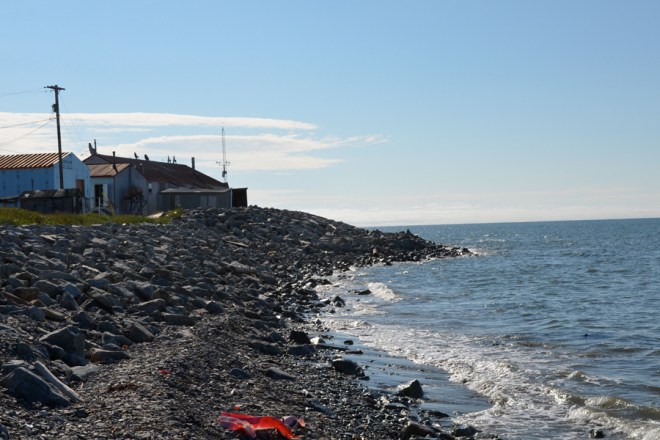
The residents of Shishmaref have moved houses away from the cliffs and constructed barriers, like this one, along the northern shore of the island to try to turn back the waves.Kate Sheppard/The Huffington Post
By this time, Shishmaref’s enthusiasm for relocation was flagging. The initial relocation plan had aimed to have the town moved by April 30, 2009, but early on it became clear that the process would likely take longer — probably more like 10 or 15 years. To buy time, the town built a 200-foot-long sea wall to protect the island’s northern shore in 2004. Since then the wall has grown, with additional sections added in 2005 and 2007, extending it to 2,800 feet.
The sea wall covers only a portion of the island, however, leaving important infrastructure like the airport, dump and a large section of the main road exposed. But Weyiouanna says it has given residents a false sense of security. He says he tried to warn other community leaders that “once we start building these sea walls, the community is going to get real comfortable with the protection of the sea wall, and pretty soon you’re going to think that we don’t need to relocate.”
Even as it reinforced the northern shore, however, other parts of Shishmaref continued to wash away. And, having made the case for relocating, it became harder to acquire state or federal funding for projects on the island, like repairing the health clinic or building additional housing.
“It stopped all investment in this community,” said Percy Nayokpuk, owner of the island’s general store, of the relocation plan. “There’s been a lot of projects lost because of the vote to move. That’s about all that’s resulted from that vote.”
City and tribal leaders say the relocation effort is largely dormant, for now. Residents who had been involved in the relocation plan said they just got busy with other things. One woman was diagnosed with cancer and had to take a break. Others said they became wrapped up with family or work, or just got frustrated with the insurmountable nature of the task.
Weyiouanna, too, stepped down from his official position with the relocation coalition toward the end of 2007. “There was a pretty strong faction of people who were against the relocation project,” he said, including community members and other local leaders. “So it just got miserable for me.”
Shishmaref had tried to move before, and changed its mind then as well. Two storms in 1973 damaged the island, after which the community decided to relocate to the mainland. But the town later reconsidered, choosing instead to build a wall of sandbags along the northern coast to fortify it against the waves. Nayokpuk worked on the relocation effort the first time around, back when he was a young man just out of college. Marshalling the support and resources to move was a challenge then, too.
Today the residents of Shishmaref are largely split on whether to move. In 2002, only about 11 percent of the town’s residents voted against the relocation plan, according to local news accounts. Many of the “no” votes were village elders, who felt that staying was important to protecting their way of life. The island’s remoteness has kept it unique, preserving the Inupiaq language and culture. Now Weyiouanna estimates that only about half of the town’s residents want to move, and the other half would prefer to stay as long as they can.
“I voted to move,” said Nora Kuzuguk, 67. “But now — not really, I don’t want to move away from Shishmaref. It’s unique.”
Stanley Tocktoo, 53, the town’s former mayor and another advocate for relocation, says he thinks they could still convince residents to move if they had a destination. “They would, I think, but we don’t know where would be a suitable place,” he replied. “We need to find a new site.”
When I met Kuzuguk’s son, Richard, he was in the mayor’s office, tendering his official resignation from the city council. In addition to serving on the council, Kuzuguk has been Shishmaref’s environmental coordinator for the last five years, leading recycling efforts from the basement of the church. He has also been involved in the ongoing campaign against Arctic drilling, and was part of the relocation planning committee in its early stages.
But now Kuzuguk, 51, and his family are packing up and moving out, bound for Nome, where he’s been offered a job doing maintenance at the hospital. It’s a full-time position, unlike his current post, and offers benefits.
For Kuzuguk, Nome is a place where he can see a future for his family. I’d met one of his six children, Lydia, on my first day in town. The gregarious 11-year-old introduced herself during movie night in the school gym, volunteering that she was moving to Nome in a few days.
“I have to consider my children’s future,” said Kuzuguk. “The best way I can do that right now is to move to Nome, get started there, introduce them to the Western lifestyle. They can always come back and learn the subsistence, traditional lifestyle.”
It’s just too complicated to move an entire town, Kuzuguk decided. “For us to teach Congress why we want to … my opinion is that’s an impossible, losing battle,” he said.
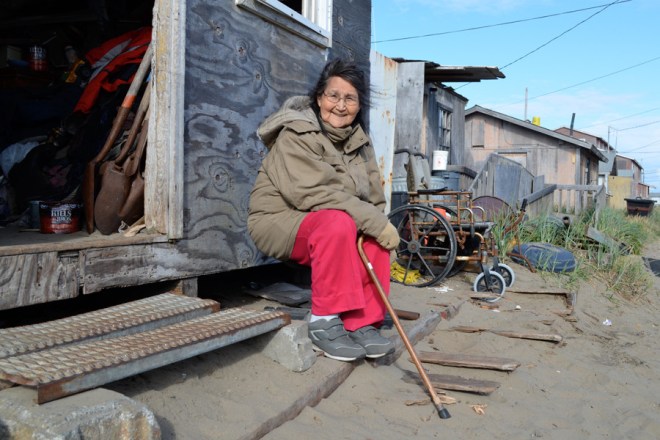
“I voted to move,” said Nora Kuzuguk, 67. “But now — not really, I don’t want to move away from Shishmaref. It’s unique.” Kate Sheppard/The Huffington Post
If it were just Shishmaref, that would be one thing. But it’s also Kivalina and Newtok, too, and nine other native villages that, facing the impacts of warmer temperatures and changing conditions as an immediate threat, have elected to relocate. The Government Accountability Office has found that most of the 200 Alaska Native villages are experiencing flooding and erosion related to climate change.
Of these villages, Newtok is the closest to actually moving. They were able to find and agree upon new land, and secure funding from state and federal agencies to start construction. Political disputes in the town, however, have put the actual move on indefinite hold there.
There’s no playbook for moving a town. There’s no government agency, at either the state or federal level, that is in charge of such a process. There’s no pool of money set aside to help communities. There are no rules for picking another location, or packing lists for what to take. Each community has been left to come up with its own plan.
“They’re doing all they can on their own,” said Robin Bronen, executive director of the Alaska Immigration Justice Project and perhaps the region’s leading researcher of climate-related migration. Bronen has followed several of these communities as they try to navigate this seemingly impossible situation. “I don’t think that folks outside of Alaska understand how incredible it is that these communities with such limited resources have been taking on a Goliath effort to educate people in Congress, in the state about their needs.”
Bronen worries that soon it won’t be just Alaska Native villages that are looking to move — it will be other coastal cities in the U.S. “My mantra is: We need to get a relocation institutional framework in place now,” said Bronen. “This does not bode well for other places in the world that are going to be faced with this issue.”
In November 2013, President Barack Obama announced a new executive order directing federal agencies to revise programs and policies that hinder climate adaptation, and created a Task Force on Climate Preparedness and Resilience that brings together state, local, and tribal leaders to collaborate on strategies for addressing the impacts of climate change.
Last month, that task force recommended that the administration “explore [the] Federal role in addressing climate change-related displacement,” echoing Bronen’s concern that the plight of communities like Shishmaref will spread to “every region of the country and U.S. affiliated jurisdictions.” In short, the task force stated, we need to come up with a way to deal with this problem — and fast.
Reggie Joule, the mayor of the Northwest Arctic Borough and a former Alaska state representative representing Shishmaref’s district, was the sole Alaska Native representative on the task force. When asked about the task force’s recommendations, Joule acknowledged that simply “exploring” the federal government’s role in relocation projects “doesn’t go far enough, because our local communities don’t have the capacity to do anything.” But he was, overall, grateful that Shishmaref and other Alaska Native villages finally seem to be on the federal government’s radar. To “be included in the recommendations the way that we are,” said Joule, “is a huge step forward, because we had very little before.”
“We’re not talking about highly populated areas. So we’re easy to overlook,” said Joule. “To people who are 7,000 miles away from where the action is, what they know and what they understand are two different things. You can know that communities are eroding, but do we really understand what that means, the timeline and how vulnerable the communities are? … When you send the pictures and put together a proposal, we’re just facts and figures on paper. And is there anybody back there [in Washington] who understands the urgency of the information in front of them?”
The Department of Interior has provided some support for the sea wall project in the past, through the Bureau of Indian Affairs. And it is working on an Integrated Arctic Management approach to bridge agency work on Arctic issues. But one of the biggest challenges at the federal level is that many of the programs that could provide assistance to a village like Shishmaref require matching local funds — which are often nonexistent. Jessica Kershaw, press secretary for the Department of Interior, told HuffPost that the department “has been coordinating with other federal agencies to evaluate the efforts that should be undertaken in situations like those facing Shishmaref” and will “continue working with a broad coalition of stakeholders to identify a path forward.”
The Army Corps of Engineers, too, has played a key role in conducting early evaluations of relocation options, as well as funding and support for sea wall construction. But the Corps’ work is limited to what Congress has authorized and funded, and that work also requires some level of cost-sharing from a local partner. Bruce Sexauer, chief of planning for the Army Corps’ Alaska district office, said the corps is currently considering funding for additional relocation or reinforcement studies for Shishmaref as part of its budget request for next year — but it’s unclear whether they will get it.
There are federal offices, like the Federal Emergency Management Agency, but their role is mostly limited to providing support after disaster strikes. “If you look at the process, I think we’re really good at reacting to things. That’s why we have FEMA,” said Joule. “But in order to address the things that FEMA may have to deal with, I’m not sure how good we are at planning.”
The Obama administration has also taken strides to address climate change around the globe. In September, the president ordered all federal agencies to “factor climate resilience into the design of their international development programs and investments.” And in November, the administration announced that it was contributing $3 billion to an international fund designed to help developing nations deal with climate change.
Officials from the Department of Interior and the White House Office of Management and Budget also traveled to Shishmaref last summer. But the continued lack of major action to help the village has prompted an outcry from Alaska’s senior Republican senator, Lisa Murkowski. “At the same time your administration has been unwilling to commit the resources to help a community such as Shishmaref, it is prioritizing funding to assist Vietnam with climate adaptation,” Murkowski wrote in a letter to Obama in January. “I ask that you put America first, especially the Alaskans who deal with this reality on a daily basis.”
Michael Boots, the acting chair of the White House Council on Environmental Quality, responded to Murkowski’s letter in May, saying that the office is “looking into how we can best address” the requests from Shishmaref. Boots noted that many of the programs that could provide assistance “may be challenging to access” for the community because of requirements for cost-sharing, but said that the administration is “committed to identifying available options” within existing executive authority.
Meanwhile in Alaska, villages are starting to wonder whether moving is even a realistic option. “We’re working hard to move a community. That’s what we’re planning for,” said Joule. “Is that even in the cards? Is that an option that somebody has the authority to say, ‘Yes, we can do this’ and is willing to do that?”
“We have taken temporary measures,” he said, “but we’re talking about people’s lives here.”
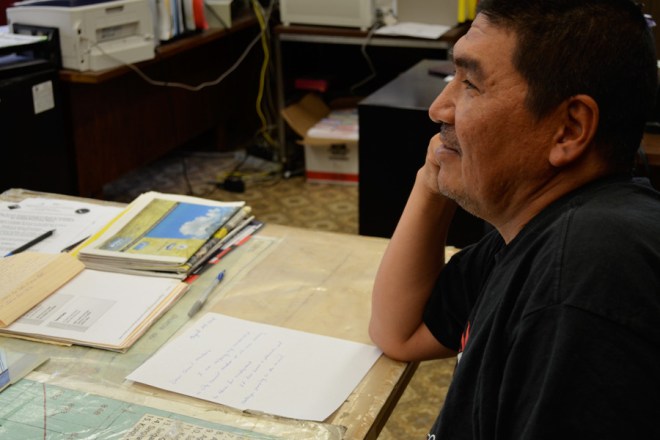
“I have to consider my children’s future,” said Richard Kuzuguk. “The best way I can do that right now is to move to Nome.”Kate Sheppard/The Huffington Post
Shishmaref’s current mayor, Howard Weyiouanna Sr., knows what it’s like to move. His house was one of the ones dragged to the other end of the island after the 1997 storm destroyed the northern coast. He was in his house through the storm. “It was pretty loud,” he remembered. “I could feel the ground shake.” Now, 17 years later, he said, “I miss hearing the ocean.”
Howard is Tony’s cousin, and Weyiouanna is one of the more common family names in town. When we met in the city council building, Howard expressed optimism about recent investments in the town. After years with little government funding, the town is finally getting new housing thanks to a grant from the U.S. Department of Housing and Urban Development. They’re putting the final touches on seven new houses, modest beige buildings with brown trim that, unlike most residences in town, will have running water and flush toilets. His adult daughter, Nellie, and his three grandkids are moving into one of them. The health clinic is also being remodeled, finally.
But a number of problems still require attention. For one, the city government building isn’t up to fire code. And they need a bigger water storage system. Most of the town relies on the reservoir, which collects snow melt, but the population has grown and that’s no longer enough. They also need a new washeteria, and larger, stronger bulk storage tanks for the fuel shipped to the island.
Such upgrades might be interpreted as signs that the community isn’t going anywhere — at least not anytime soon. But one thing that worries the mayor is the road that leads to the dump, past the airport at the far western end of the island. The island’s remoteness means that pretty much everything that comes in, stays in. The dump, located at the farthest end of the island, is filled with remnants of refrigerators, barrels, household trash, an old truck. And since most houses lack indoor plumbing, the dump is also where human waste is deposited in a large lagoon. A storm in November 2013 washed out several big chunks of the road, taking out 50 feet of earth in some places and making the dump nearly inaccessible.
The town rerouted the road around the washout. But everyone knows it’s a temporary solution.” Apparently it is going to breach again,” Weyiouanna said.
Losing the road to the dump alone would be bad enough, but of more concern is the sea’s encroachment on the end of the runway. More than a place to land planes, it’s the town’s lifeline, bringing in food, supplies, and people. And it’s the only way out if there’s an evacuation. In previous storms, the water’s high point has crept as close as 75 feet from the landing strip.
“With no protection on it, it’s going to hit the runway,” said Weyiouanna.
Ideally, he says, they’d find more money to extend the sea wall to protect the rest of the northern shore. “It would buy us some time,” he said, “but I can’t say for how long.”
Indeed, climate change makes the prospect of a big, dangerous storm — and emergency evacuation — more a matter of when, not if. Such a disaster would likely mark the end of Shishmaref as an independent village, Kuzuguk said.
“Once they get evacuated, nobody’s going to be allowed to come back to the island,” he said. They would become refugees, in Nome, or Fairbanks, or Anchorage.
That’s the one thing many in Shishmaref would like to avoid. The whole point of kicking off a relocation plan, after all, was to ensure that Shishmaref could still be a village — just somewhere else. By moving together, they hoped, they could safeguard the things that make them unique, like their subsistence lifestyle and customs.
Kuzuguk isn’t optimistic on that point, not anymore. “I don’t think there’s enough reasonable people who know we have to relocate by choice, rather than being forced to by evacuation. By choice, we could still retain our identity, as a culture, as a community,” he said. “But unless we’re willing to do it ourselves, it’s not going to happen.”
Tony Weyiouanna Sr., despite his past frustrations with the relocation process, hasn’t given up. “I still believe in it. I still tell people I think we need to relocate,” he said. “I still think it’s important to have some spokesperson to go out there, to keep telling the stories, to pass on your experiences, let people know that the assistance is still needed.”
He has a new idea, one he pitched to lawmakers, agency heads, and White House officials during a trip to Washington earlier this year. Instead of moving the whole town, maybe they could try a pilot relocation project, he said, with “only the group who really wanted to move.”
He’s still trying to figure out exactly how many people would need to volunteer in order to qualify for state and federal support to build a new health clinic and a new school. But a pilot move like this, he believes, would work out the complicated issues, like finding a viable location, and would provide a road map for other communities as they face the same challenge. And it would cost about half of what they projected a bigger move would cost.
“We just have to do the planning,” he told me. “We just have to start over and do the planning.”
He thinks they could make it work, maybe in a year or two years. “Everybody else will follow eventually.”
 This story was produced as part of the Climate Desk collaboration.
This story was produced as part of the Climate Desk collaboration.

